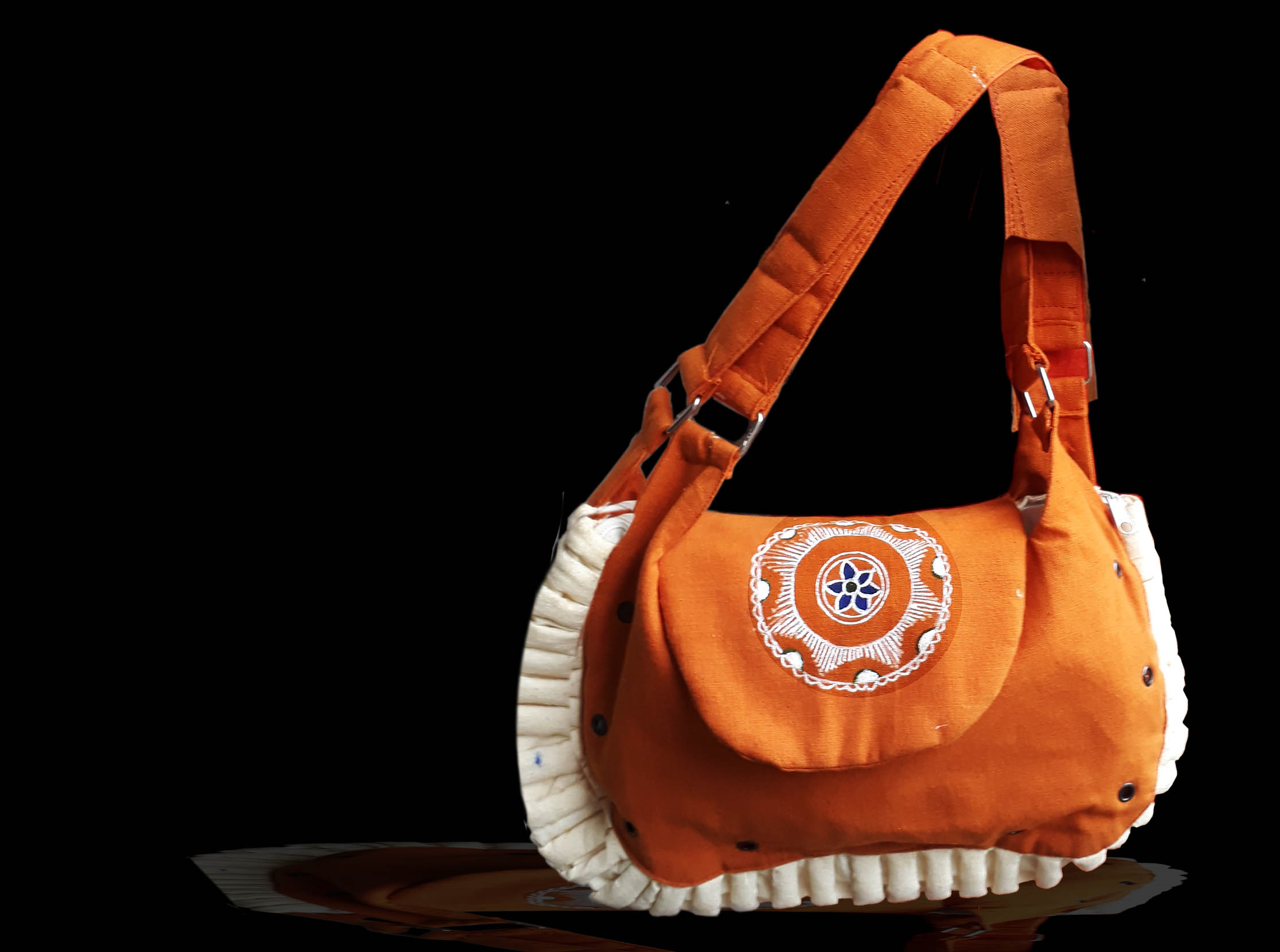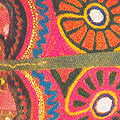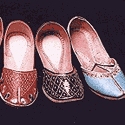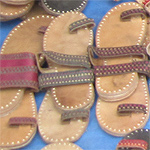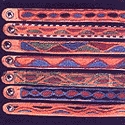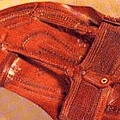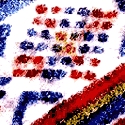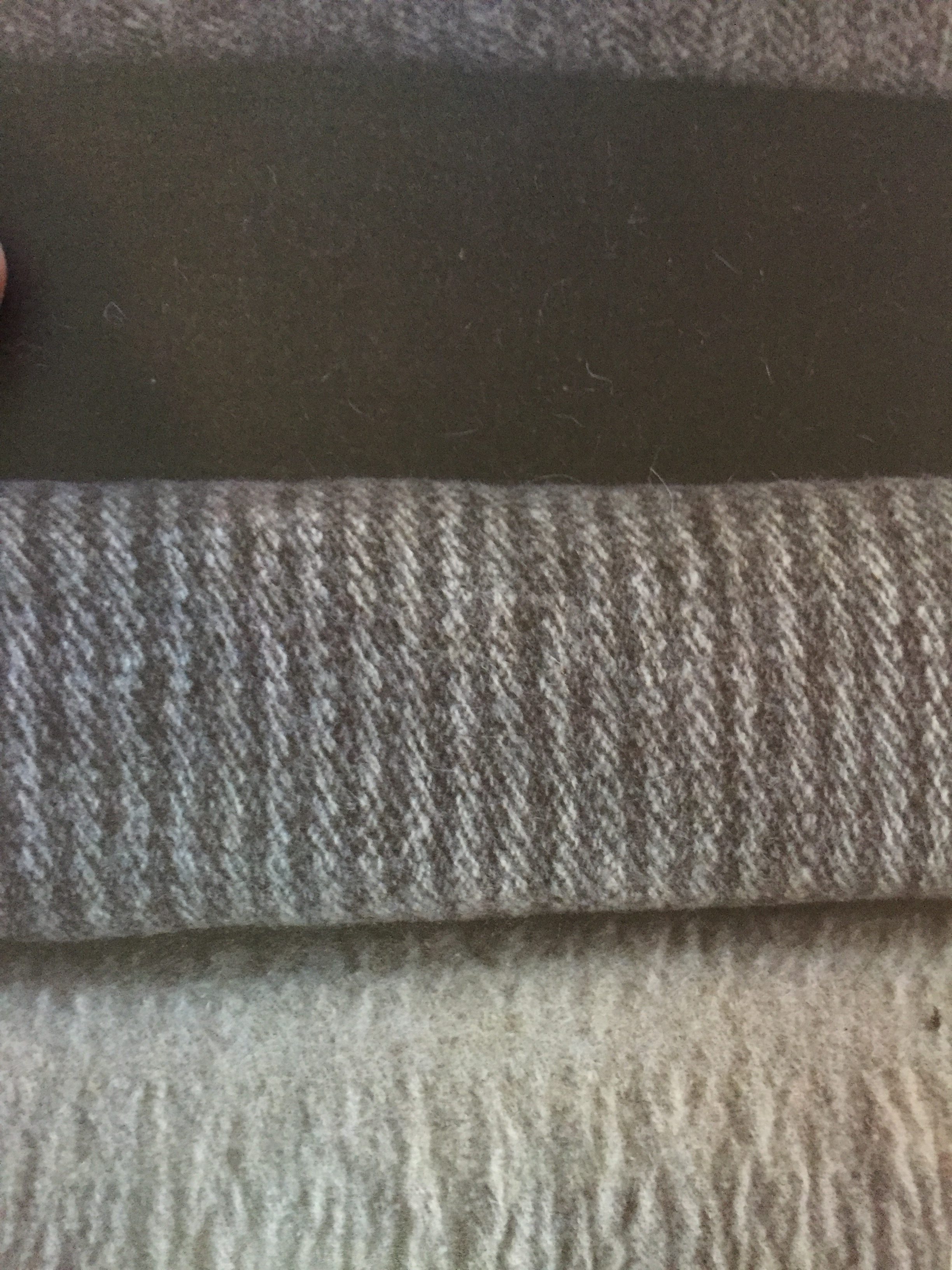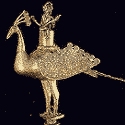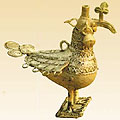Hand-tool etching on leather is done in Auroville in Pondicherry. The terracotta coloured leather allows the artist to etch and braid by hand, and then colour the item in two main colours, tan and brown mixed with black.
In the villages a large number of artisans continue to use home-cured leather to stitch sturdy shoes or make attractive animal trappings. The water-carrier still uses a leather mashk to bring water from the well and where water to irrigate lands is drawn from wells the charas is quite commonly used. Leather is also used in the hookah bottle. In Peshwar and Rawalpindi, where most of the tongas/horse drawn carriages are painted and decorated with loving care, horse trappings are embroidered and studded with brass nails, strips and cut-out patterns. Besides, leather artisans turn out travelling kits, belts, sword-sheaths, gun-cases, sports goods, ladies hand-bags, purses, pouches and whips in different shapes. Many of these items are decorated with, besides embroidered patterns, beads and appliqué work. Stool-sized leather cushions were quite popular till some time ago but now most people use leather for only the top of pirhis and moorhas. A number of other leather goods are made from skins. There is a sizable production of shoes, hand-bags, pouches and wallets made of reptile skins. In these items, however, the craftsmen concentrate on experimenting with forms and little effort is made to interfere with the natural pattern on the skin. Another branch of craftsmen has taken to producing caps from Karakul skins, the most famous variety of which is called Jinnah Cap since it was adopted by the founder of the State, Quaid-I-Azam Mohammad Ali Jinnah.
The Nepalese community of traditional cobblers and professional tanners, the sarki have been working with leather for centuries. Working with the most elementary of tools, the sarki traditionally hand-craft leather products that include shoes, bags, belts, rugs, horse saddles, knife cases, head straps, and ropes. Their work includes not only the hand-crafting of leather products but also the tanning of the skin of buffaloes, goats, sheep, the high Himalayan cow, and the yak.
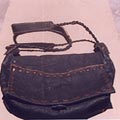



Tilla juttis, adorned with tilla zari tilla (silver and golden wire) work and phulkari embroidery, are characteristic of the craft traditions of Punjab. These juttis are hand-stitched with embroidered uppers and insoles, no nails are used in the construction and there is no distinction made between the left and right foot. The leather uppers are embroidered, punched, studded, sequined, and stitched in a variety of fascinating traditional designs. Jutti making is a family based occupation with the women embroidering the shoe uppers while the men make-up the shoe using cowhide for the uppers and buffalo hide for the sole.
The juttis are usually intricately decorated with gold and multicoloured threads in varying patterns in different parts of Punjab. The most well-known centre is Patiala, where the Patiala juttis are embellished with zari, salma, tilla, and cotton threads their specialty is the khussa jutti characterized by its upturned toe. . In Fazilka where craft families have migrated from Bhawalpur and Deepalpur in Pakistan the juttis are embroidered in check patterns. In Hall Raod, Malot Raod, Goniana Road centers in Muktsar the juttis are usually multi colored. In Thakur Abadi, Ramdevnagar, Gali, Bazaar Park, Idgah-Basti and Dayal Nagar in Abohar the juttis produced are very light weight and are embossed, cut worked, appliquéd and beaded rather than embroidered. While the juttis in Malerkotla in Sangrur district are defined by their fine, and dense work.
The other well known centers include in Khai Road, Ralia, Hata, Mochi Bazaar, Ghantaghar chowk, Indra Market in Ferozepur; Guru Ravi Das Nagar in Malot; Sirki Bazaar, Court road, Ram Bagh Road in Bhathinda; and Faridkot and Kotakpura; Malwa where several centers are located
Mojris (or jootis or pagarkhiyas) is foot wear made in Rajasthan from locally cured leather. They are very well-known for the quality of workmanship and the variety and richness of design. They are entirely hand-crafted and are measured with the fingers. The process followed is for different layers of the sole to be stuck with home-made glue. Once this is dry, the sole is stitched with cotton or leather thread. The upper portion is then embroidered by women who are very skilled at this. Plain or coloured piping is stitched to the edge of the inside portion of the upper form after the leather is dipped in water to make it soft. At every stage the leather is hammered to make the stitching and the pasting firm. When the upper form has been attached to the sole it is put on a wooden last to give it a final shape; local dyes are sometimes sprayed on the upper in shades of red, green, and dark pink. Simple tools like a needle, a knife, a wooden block, and a hammer, are used. There is a thin strip of leather attached to the front edge of the sole, curling around the toe and joining the upper form, which protects the toe. On the back portion, a strip of leather stands out by an inch to enable the wearer to pull on the jooti. The stitching on the sole is always done with several strands of cotton thread. The simplest form of the jooti has a plain leather upper form, stitched to a plain sole. There is no difference between the right and the left foot and the jooti takes the shape of the wearer's foot. The ornamentation is with silk or metal embroidery or beads and the designs are done in appliqué with thin leather pieces of different colours. This work is called as kashidakari. Jootis are also dyed in various colours and have brass eyelets adorning them. The soles have designs or patterns stitched with thread or appliquéd with small leather pieces of different shapes. Jaipur is the main centre for this craft and the mojris are made so daintily that they can be rolled into a little ball. The designs are delicate and the colours are subtle. The embroidery in Jodhpur has patterns which has bolder shades and interesting contrasts. Peshawari is the most common type of jooti: this is a heavy variety used by both men and women. A lighter Peshawari jooti without embroidery is made for children. Nagra jootis are made and sold in towns. They are the lighter variety and consist of one or two layers of leather for the sole and are embroidered with Mughal motifs in gold (and brightly coloured) threads.
The leather work of Kutch is crafted by the Marwadi Meghwal community of Kutch. Leather is obtained from the Maldhari Muslim cattle herders with whom they live in close proximity. The construction of the footwear is undertaken by the men and the womenfolk are responsible for carrying out the embellishments. Tools such as marking tools called krapli, scrapers called karpa and scraping knives called rampi, large and small awls called moti and nani ari respectively, needles, cutters and pliers wood, lasts, iron beetles, hammers, buffalo horns, stone slabs and punches are used in the crafting process. Articles such as leather ropes, footwear, slippers, shoes, decorative door hangings, hand fans, horse saddels, covering for the seat in camel trappings, belt and necklace etc are made. Additionally articles such as mirror frames, wallets, folders, bags and pouches are crafted. [gallery ids="176393,176392,176390,176389"]
There are several communities involved in making products from leather, with each dealing with a separate process. The people who flay the animals are distinct from the tanners who use a process locally known as rangna. The makers of saddle products are jingarhs and the makers of musical instruments are debgars. In the hands of the artisan, the hide is transformed with skill and dexterity into a range of different and unusual products. Another leather product is the knucklepad on which miniature landscapes and festive scenes are embroidered like in Rajput paintings. The details of the embroidery are carefully worked out, especially of group compositions, and the scenes depicted include human figures, along with floral and bird designs. Bikaner and Jaisalmer are known for ornately decorated leather saddles for horses and camels. Leather shields prepared with lacquer colour paint are made in Shahpura, though these are not used any more. Leather bookbinding in Alwar is of extremely good quality. Designs are painted on the leather after they are outlined with a brass block. The covers have borders either in various shades or on a gold coloured base.
The juttis of Haryana are sewn out of locally cured leather and then either made-up as plain sturdy footwear or ornamented.I n the two well known centers they specialize in one or the other style of jutti. In Hissar they specialize in the sturdy and hard-wearing unadorned juttis locally called desi jutti. Used mainly by laborers, construction workers and farmers, both men and women, for their daily work. These juttis have a one-piece upper of thick hide that is further reinforced for strength at the heel with appliqué, while the sole is made from several layers of buffalo hide that are stitched with thick cotton thread. They come in two varieties –munde or round toe shaped and the ghuni or pointed jutti. The more ornate tilla juttis with their uppers adorned with silk, metal embroidery, beads, and designs done in appliqué and with thin leather pieces of different colours and are made in the round-toe, pointed-toe and curled-toe variety. The designs are extremely delicate and the colours used are vivid ones. Made in Jatia Mohalla, Rampura village, Odhi Village, Bolni Qutubpur in Rewari and Jhajjar district the specially sophisticated and expensive juttis are made in black leather that is embroidered with gold wire. An equally colorful item is the embroidered knuckle pad. While the Tokni or water container is made to order.
In recent years there has been a huge market demand for Kolhapuri chappals both nationally and globally. These open toe sandals are made using tanned leather which is produced using traditional techniques and tools. This crafted footwear originates from Kolhapur, Maharashtra and thus its name of Kolhapuri chappals. The chappals can be easily recognized by their customary look which often have a decorative woven pattern on the band of the footwear. Sandal making has been a traditional source of occupation for the people of Kolhapur, as all work is done by hand. From the stitching of the sole to the staining of the leather all the stages require skill and mastery. All the parts of the chappals from the sole, welt and heel are tinted using the locally prepared vegetable dyes. The woven patterns over the toe band provide an aesthetic contrast to the leather.
Leather goods from Santiniketan are exquisite and colourful handcrafted products that reflect the cultural and social values of the region. Several types of merchandise are produced, including block printed and batik dyed products, which have smooth and glazed surfaces. Such products are much admired for their craftsmanship, softness, grained effect and aesthetic value. Santiniketan Leather Goods are famous because of the use of batik, appliqué, stencilling, modelling and embossed relief work.
The city of lndore, 188km from Bhopal, the capital of Madhya Pradesh, is situated in the southwest direction of the state. Indore is a progressive city and is also termed as mini Mumbai because of its advanced technology, lifestyle and large number of textile mills. The leather toys produced here seem almost lifelike, and are moulded in such a way that they appear animated. For example, a horse can be seen going through different motions—running, jumping, grazing, neighing, galloping, stationary. Such postures offer the buyer a range of options to choose from. Other animals such as elephants are similarly portrayed. The texture of the skin of the animal is achieved by using pointed tools on the paper pulp when it is still wet and applied by hand on to a hay mould, keeping in mind the animal in question. This is what makes the toy look realistic. The texture is further enhanced after it has been dyed and hand-painted in deeper shades.
Sikkim is home to three distinct tribes - the Lepchas, the Bhutias - immigrants from Bhutan, and the Tsongs, hailing from Nepal. The three races coexist and the muted harmonious colours of the Lepchas can be seen along with the gay silks of the Bhutias and the heavy ornaments of the Tsongs.
Lepcha-weaving is native to Sikkim and goes back to ancient times when the Lepcha’s used yarn spun out of natural fibre – nettle, also known as sisnu, for Handloom weaving. The Lepcha weaves, locally known as thara are woven on back-strap loin loom and thus, results in a short fabric width. Cotton, used as a base material is combined with multi-hued motifs woven in woollen yarn. Although, vegetable dyes were used extensively earlier, over the years synthetic colours have also been introduced as the yardage is converted into several products – bags, belts, furnishings and Lepcha’s traditional coat material.
Locally available sheep wool is also utilised and combined with cotton to weave blankets, shawls, Lepcha duree – width ranges from 30 to 36 inches, woven jackets. While the design decides the volume of colour, traditional colours are white, black, red, yellow and green.
One man's passion has made Chandernagor, a former French colony synonymous with light makers. Sridhar Das, fascinated by the working of electric objects gave rise to this 50-year-old cottage industry of a unique art of illumination. These exquisite illuminations are based on primitive equipments. An example of the art is a fan roller, which rotates, and the wooden cylinder with its copper strips light up and switch off thousands of little light bulbs on the bamboo trellis frame. Presently, this craft is providing livelihood to about 12,000 artisans in Chandernagor. As this crafts include, light-makers, raw material suppliers, artists (who make design) carpenters (who make the wooden frame for the bamboo structure) and the entire team that makes the circuits. But the increasing cost of power has affected this cottage industry.
The wood carving tradition of Uttarakhand is an integral part of the hill society and is also known as Likhai. The carving is found on the dwellings primarily in the form of folk, religious and tantric motifs. Tantric art forms an important part of the Kumaon region. The carving is done in the form of stylized plants and geometrical motifs into a single window and door. The borders of the door sometimes have up to 14 rows of carvings- swans, parrots, lotus, creepers etc. The panels are carved separately and joined together after the carving is done. Munsyari in Pithoragarh district is a noted centre for wood carving. The houses are adorned with Tibetan motifs like the three-flower motif, the arch and dragons. In Garhwal region the carving is limited to the temples. Likhai art is languishing today because of the rising cost and unavailability of good raw wood.
The weaving clusters of Imlikhera, Dharampura, Mangalore, Mohanpura and Ladora, near Dehradun, make shawls, blankets, yardage which they expansively refer to as loi. The lightweight Loi blankets, woven from mill made blended wool are the best across the state due to their optimum pricing. The blanket is used as a shawl by both men and women. The weaving industry here belongs to the Pal community who were once weavers as well as shepherds or gadariya of indigenous black colored sheep.

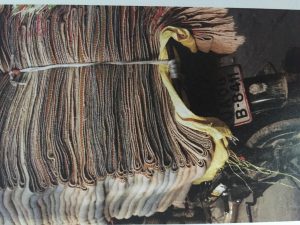
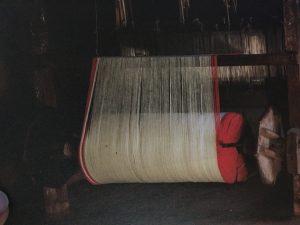
The metal craftspersons of Bastar are called Ghadwas. Though concentrated in Kondagaon and Jagdalpur, they are found all over the region. The term Ghadwa means shaping and creating. The other tribal groups engaged in bronze-casting techniques are the Malars of Sarguja, the Jharas of Raigarh, the Bharewas of Betul, and the Swarnakars of Tikamgarh. In all the regions mentioned above, the bronzes are cast using the cire perdue or lost wax technique. Slight variations arise due to local differences in raw materials, though the furnaces and tools used are the same. The tools are made by local blacksmiths and carpenters, and the artisans themselves. These tools --- farni, mutni, dhokna, chimta, sooja, hathawri, dhorkin, darga, pinachaku, and seikanta --- are similar to the tools used all over the state. Traditionally, the Ghadwas were engaged in casting utensils; however, there has been a decline in the demand for these in recent times. They have shifted to making ornaments like ghungroos or anklets, toe rings, and fullis or nose pins. They also make votive forms of snakes, elephants, horses, and the kalash or ritual pot. Adjustments have been made to accommodate the decreasing interest in traditional ornaments and the increasing demand for idols and ritualistic forms from outside Bastar. The figures made by them now include a number of birds and animals, decorative objects, and faces. The Malar tribal group of Sarguja make utensils, measuring vessels, chimni oil lamps, birds and animal figures, and images of deities. Both solid and hollow figures are crafted. The hollow figures are further classified into those from which the inner clay core has been removed and those from which it cannot be removed. The gava or core figure is made from a mixture of black soil and rice husk, kneaded with water. On drying it is covered with a mixture of cow dung and clay. The details of the figure ---facial features, ornaments, and clothes --- are all made on the mould after applying a coating of thin strips of resin (obtained from the sarai or saal tree). The figure is again covered with a thin layer of clay solution, after which it is covered with clay mixed with cow dung and then clay obtained from an anthill (mixed with rice-husk). A chika or receptacle made from the same clay-rice-husk mixture is then fixed to the lower portion of the image. A cup is filled with the required quantity of metal pieces and sealed with the clay-husk mixture. The closed cup is called moheti. The figure is then cast in the furnace with dhavha (anogesus latefova) or saal (shoraea robusta) wood or else charcoal is used for the firing. The moulds are arranged in the furnace over the cup containing the metal pieces. Once the firing process is done, the moulds are taken out, turned upside down and given a brisk shake. The molten metal flows into the space occupied by the resin. The moulds are cooled and the clay layer hammered away to reveal the metal image. The Jharas of Raigarh, Mahasamund, and Jashpur districts make a wide variety of lamps, deities, and household objects. The metal craft of Tikamgarh involves the same lost wax technique. Only beeswax is used at Bastar, whereas only the resin of saal or sarai is used at Sarguja; the craftspersons in Raigarh and Tikamgarh prepare two different types of wax by mixing resin and beeswax in different ratios. At Tikamgarh, traditionally only jewellery and utensils were made by this method though nowadays icons and images are also made. There is a growing demand for icons, boxes, and other objects made by the cire perdue process. The craft is practised by sunaror or goldsmith caste. The various kinds of traditional utensils made include the ghunghta or gudguda, basna, hukka, dhak, galgota, danka, puliya, and khichdi ka bela. Jewellery items include the paijania, toda, ghunsi, peti, gujri, chulla, bichhua, kardhona, bajubandh, hansuli, tikli, jhumki, chura, tidana, muttermala, tadia, hai, parosun, kochia, gajra, chhunni, belchuda, and kangan. On the occasion of Makar Sankranti, horses, elephants, thrones of thakurji, chariots, and oxen are made as votive offerings. The tribal group which makes objects by pouring or filling molten metal into the mould are called Bharewas. They reside in the district of Betul, and make utensils, bells, jingles, lamps, elephants, horses, Shiva lingams and bird figures.
Dhokra non-ferrous metal casting is done using lost wax technique. The Dhokra metal casting of Madhya Pradesh is mainly of two types; the one with bronzes made using cir? perdue (lost wax method) and the other indigenous method of iron smithy. The first techniques uses filling up of molten metal into the mould. The product range includes utensils, harnesses for horses, idols of tribal deities and bird figures. Dhokra metal casting is not main occupation but side work along with agriculture. Traditionally, the profession provided for ritual requirements for example a dagger worn by the groom during the marriage ceremonies. Another example would be gifting an oil wick lamp to the bride by her family that resulted in many forms of lamps. The production clusters of the lost wax metal casting in Madhya Pradesh include Chunahazuri, Phongaria, Barkhed, Tigaria, Kalmeshara, Sitakamath, Patakheda, Amla. The craft has now taken a commercialtake over and many contemporary products have found demand in urban markets.
